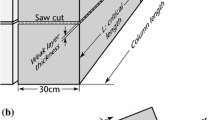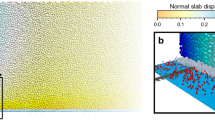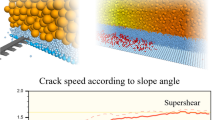Abstract
Field observations and measurements show that dry snow slab avalanches initiate by propagating shear fractures within a relatively thin weak layer sandwiched between a planar, stronger, thicker slab above and stronger material below. After initiation, the weak layer fracture can propagate up and down slope for distances which range from about 10 to 100′s of meters to cause tensile fracture through the body of the slab which results in avalanche release. In this paper, dynamic fracture mechanics is applied to slab tensile fracture after which avalanche release is imminent. Two mechanisms for production of tensile stress are explored employing field measurements of slab properties and lab measurements. The first considers inertial effects related to quasi-brittle fracture near the tip of a propagating weak layer shear fracture. The second is concerned with the tensile stress generation from the stress drop behind the crack front as the fracture propagates in the weak layer. Analysis suggest that both mechanisms can contribute to produce the tensile fracture line which precedes avalanche release. Even though both mechanisms may operate together, they are analyzed separately in this paper.







Similar content being viewed by others
References
Armstrong RL, Ives JD (1976) Avalanche release and snow characteristics, San Juan Mountains, Colorado, Occasional Paper 19. INSTAAR, University of Colorado
Bader H, Kuriowa D (1962) The physics and mechanics of snow as a material. Technical Report II-B. CRREL, Hanover
Barenblatt GI (1962) Mathematical theory of equilibrium cracks in brittle fracture. Adv Appl Mech 7:55–129
Bažant ZP (2005) Scaling of structural strength, 2nd edn. Elsevier, Amsterdam
Bažant ZP, Planas J (1998) Fracture and size effect in concrete and other quasibrittle materials. CRC Press, Boca Raton
Bažant ZP, Zi G, McClung DM (2003) Size effect law and fracture mechanics of the triggering of dry snow slab avalanches. J Geophys Res 108(B2):2119. https://doi.org/10.1029/2002JB
Borstad CP (2011) Tensile strength and fracture mechanics of cohesive dry snow related to slab avalanches. PhD Thesis, University of British Columbia
Broberg KB (1999) Cracks and fracture. Academic, London
Brown CB, Evans RJ, LaChapelle ER (1972) Slab avalanching and the state of stress in fallen snow. J Geophys Res 77(24):4570–4580
Burridge R, Knopoff L (1967) Model and theoretical seismicity. Bull Seismol Soc Am 57(3):341–371
Camponovo C, Schweizer J (2001) Rheological measurements of the viscoelastic properties of snow. Ann Glaciol 32:44–50
Fierz C, Armstrong RL, Durand Y, Etdhevers P, McClung DM, Nishimura K, Satyawali PK, Sokratov SA (2009) The international classification for seasonal snow on the ground. IHP-VII Technical Documents in Hydrology, IACS Contribution No. 1. UNESCO-IHP, Paris
Flűgge W (1975) Viscoelasticity, 2nd edn. Springer, New York
Freund LB (1973) Crack propagation in an elastic solid subjected to general loading. III. Stress wave loading. J Mech Phys Solids 21:47–61
Freund LB (1990) Dynamic fracture mechanics. Cambridge University Press, Cambridge
Fung YC (1965) Foundations of solid mechanics. Prentice-Hall, Englewood Cliffs
Gaume J, van Herwijnen A, Chambon G, Birkeland KW, Schweizer J (2015) Modeling of crack propagation in weak snowpack layers using the discrete element method. Cryosphere 9:1915–1932. https://doi.org/10.5194/tc-9-1915-2015
Gaume J, Gast T, Teran J, van Herwijnen A, Jiang C (2018) Dynamic anticrack propagation in snow. Nat Commun 9:3047
Gaume J, van Herwijnen A, Gast T, Teran J, Jiang C (2019) Investigating the release and flow of snow avalanches at the slope-scale using a unified model based on the material point method. Cold Reg Sci Technol. https://doi.org/10.1016//j.coldregions.2019.102847
Gauthier, D (2007) A practical field test for propagation and arrest in weak snowpack layers in relation to slab avalanche release. PhD Thesis, University of Calgary, Alberta
Gauthier D, Jamieson JB (2008) Evaluation of a prototype field test for fracture and failure propagation in weak snowpack layers. Cold Reg Sci Technol 51(2–3):87–97. https://doi.org/10.1016/j.coldregions.2007.04.005
Hamre D, Simenhois R, Birkeland KW (2014) Fracture speeds of triggered avalanches. In: Proceedings of the international snow science workshop, Banff, AB, Canada, pp 174–178
Heaton TH (1990) Evidence for and implications for self-healing pulses of slip in earthquake rupture. Phys Earth Planet Inter 64:1–20
Heierli J, Gumbsch P, Zaiser M (2008) Anticrack nucleation as triggering mechanism for snow slab avalanches. Science 321(5886):240–243. https://doi.org/10.1126/science3.1153948
Jamieson JB, Johnston CD (1990) In situ tensile tests of snow-pack layers. J Glaciol 36(122):102–106
Jamieson JB, Johnston CD (1992) A fracture-arrest model for unconfined dry slab avalanches. Can Geotech J 29:61–66
Kostrov BV (1975) On the crack propagation with variable velocity. Int J Fract 11(1):47–56
Lang TE, Brown RL (1975) Stress concentration in sloping snowpack from geometric imperfections. IAHS-AISH Publication 114, pp 311–320
Malvern LE (1969) Introduction to the mechanics of a continuous medium. Prentice-Hall, Inc., Upper Saddle River
McClung DM (1974) Avalanche defense mechanics. PhD Thesis, University of Wash, Seattle
McClung DM (1977) Direct simple shear tests on snow and their relation to slab avalanche formation. J Glaciol 19(81):101–109
McClung DM (1981) Fracture mechanical models of dry slab avalanche release. J Geophys Res 86(B11):10783–10790
McClung DM (1987) Mechanics of snow slab failure from a geotechnical perspective. In: Avalanche formation, movement and effects. IAHS Publication 162, pp 475–508
McClung DM (2005) Approximate estimates of fracture speeds for dry slab avalanches. Geophys Res Lett 32:L08406. https://doi.org/10.1029/2005GL022391
McClung DM (2009) Dimensions of dry snow slab avalanches from field measurements. J Geophys Res Earth Surf 110(F4):F04008
McClung DM (2013) Effects of triggering mechanism on avalanche slope angles and slab depths from field data. Nat Hazards 69:1721–1731
McClung DM (2015) Mode II fracture parameters of dry snow slab avalanche weak layers calculated from the cohesive crack model. Int J Fract 193:153–169. https://doi.org/10.1007/s10704-015-0026-1
McClung D, Schaerer P (2006) The avalanche handbook, 3rd edn. The Mountaineers, Seattle
McClung DM, Borstad CP (2012) Deformation and energy of dry snow slabs prior to propagation. J Glaciol 58(209):553–564. https://doi.org/10.3189/2012JoGG11J009
McClung DM, Borstad CP (2019) Probabilistic size effect law for mode II fracture of critical lengths in snow slab avalanche weak layers. J Glaciol 65(249):157–167. https://doi.org/10.1017/jog.2018.88
McClung DM, Schweizer J (2006) Fracture toughness of dry snow slab avalanches from field measurements. J Geophys Res Earth Surf 111:F04008. https://doi.org/10.1029/2005JF000403
Mellor M (1968) Avalanches. Technical Report III_A3d. CRREL, Hanover
Mellor M (1975) A review of basic snow mechanics. IASH Publication 114, pp 251–291
Palmer AC, Rice JR (1973) The growth of slip surfaces in the progressive failure of over-consolidated clay. Proc R Soc A 332:527–548
Perla RI (1971) The slab avalanche. PhD Thesis, University of Utah, Salt Lake City
Perla RI (1975) Stress and fracture of snow slabs. IAHS-AISH Publication 114, pp 208–221
Perla R (1977) Slab avalanche measurements. Can Geotech J 14:206–213
Perla R, LaChapelle ER (1970) A theory of snow slab failure. J Geophys Res 75(36):7619–7627
Ravi-Chandar K (2004) Dynamic fracture. Elsevier, Amsterdam
Reiweger I, Schweizer J (2010) Failure of a layer of buried surface hoar. Geophys Res Lett 37(24):L24501. https://doi.org/10.1029/2010GL04533
Reiweger I, Schweizer J (2013) Weak layer failure: facets and depth hoar. Cryosphere 7(5):1447–1453. https://doi.org/10.5194/tc-7-1447-2013
Roch A (1966) Les déclenchements d’avalanches. In: AIHS Publication 69, international symposium on scientific aspects of snow and ice avalanches, 5–10 April 1965, pp 182–198
Rice JR (1968) Chapter 3: mathematical analysis in the mechanics of fracture. In: Liebowitz H (ed) Fracture: an advanced treatise, vol II. Academic, New York, pp 191–311
Rice JR (1980) The mechanics of earthquake rupture. In: Dziewonski AM, Boschi E (eds) Proceedings of the International School of Physics <<Enrico Fermi>> Course LXXVIII, Lake Como, Italy. Physics of the earth’s interior. North-Holland Publishing Company Amsterdam, pp 555–649.
Rice JR, Sammis GC, Parsons R (2005) Off-fault secondary failure induced by a dynamic slip pulse. Bull Seismol Soc Am 95(1):109–134. https://doi.org/10.1785/0120030166
Rosakis AJ, Samudrala O, Coker D (1999) Cracks faster than the shear wave speed. Science 284:1337–1340
Rousseau CE, Rosakis AJ (2003) On the influence of fault bends on the growth of sub-Rayleigh and intersonic shear ruptures. J Geophys Res 208(B9):2411. https://doi.org/10.1029/2002JB002310
Scapozza C (2004) Entwicklung eines dichte- und temperaturabhängigen Stoffgetsetzes zur Beschreibung des visko -elastichen Verhaltens von Schnee. PhD Thesis, ETH, Zürich
Schofield A, Wroth P (1968) Critical state soil mechanics. McGraw-Hill Book Company, New York
Schweizer J (1998) Laboratory experiments on shear failure of snow. Ann Glaciol 26:97–102
Schweizer J, Jamieson JB, Schneebeli M (2003) Snow avalanche formation. Rev Geophys 41(4):1016. https://doi.org/10.1029/2002RG000123
Sigrist C (2006) Measurement of fracture mechanical properties of snow and application to dry snow slab avalanche release. ETH No. 16736. PhD Thesis, Swiss Federal Institute of Technology, Zűrich
Shinojima K (1967) Study on the visco-elastic deformation of deposited snow in Physics of Snow and Ice. In: Ōura H (ed) International conference on low temperature science, vol 1, Part 2, pp 875–907
Tada H, Paris PC, Irwin GR (2000) The stress analysis of cracks handbook. ASME Press, New York
Sih GC, Liebowitz H (1968) Chapter 2: mathematical theories of brittle fracture. In: Liebowitz H (ed) Fracture: an advanced treatise, vol II. Academic, New York, pp 67–190
van Herwijnen A, Heierli J (2009) Measurement of crack-face friction in collapsed weak snow layers. Geophys Res Lett 36(23):L23502. https://doi.org/10.1029/2009GL040389
Xia KW, Rosakis AJ, Kanamori H (2004) Laboratory earthquakes: the sub-Rayleigh-to-supershear rupture transition. Science 303:1859–1861
Author information
Authors and Affiliations
Corresponding author
Additional information
Publisher's Note
Springer Nature remains neutral with regard to jurisdictional claims in published maps and institutional affiliations.
Appendix: Considerations from the elastic equation of motion
Appendix: Considerations from the elastic equation of motion
Alpine snow is generally not an elastic material. However, it is useful to explore the results of application of the equation of motion which contains the assumption of elasticity. Equation (5) gives the equation of motion employing the separable form (4). As an example, consider initially the mode II stress intensity factor for a semi-infinite crack in an unbounded elastic solid. For the present case:
The equation of motion is then given by (e.g. Freund 1990):
where \(l_{c} = {{E^{\prime}\Gamma_{II} \pi } \mathord{\left/ {\vphantom {{E^{\prime}\Gamma_{II} \pi } {8\left( {\tau_{g} - \tau_{r} } \right)}}} \right. \kern-\nulldelimiterspace} {8\left( {\tau_{g} - \tau_{r} } \right)}}^{2}\).
From the field measurements of PST, the median value \(l_{c} = 0.30{\text{ m}}\). Equation (26) contains the prediction that the crack speed could reach 99% of the Rayleigh speed in a distance of about 30 m. The distances measured by Hamre et al. (2014) had a range: 12–278 m. with a mean 81 m and median 35 m. Equation (18) predicts infinite tensile stress at the Rayleigh speed (Rice 1980).
These results depend on the form of \(K_{II} (l,\;0)\). In general, for a stress intensity factor: \(K_{II} \propto l^{n}\), it is required that \({{\partial K_{II} } \mathord{\left/ {\vphantom {{\partial K_{II} } {\partial l > 0}}} \right. \kern-\nulldelimiterspace} {\partial l > 0}}\) (or \(n > 0\)) to produce a running crack (Rice 1968) and maintain acceleration. The equation of motion is then:
Palmer and Rice (1973) proposed a form: \(K_{II} \propto l\) which has been applied to initiation of dry slab avalanches (McClung 1981). In this case (n = 1) with \(l_{c} = 0.30\;{\text{m}},\) the speed would reach 99% of the Rayleigh speed within 3 m.
The conclusion from these results is that completely elastic modelling is unrealistic which is as expected for alpine snow. The implied avalanche dimensions and propagation distances are too short compared to field measurements.
From (27) the acceleration is given by:
Equation (28) suggests that the acceleration is proportional to \(C_{R}^{2}\). From Table 1, the acceleration for density \(300\;{\text{kg}}/{\text{m}}^{3}\) is expected to be 10 times that for 100 kg/m3 for 1 Hz and about 8.5 times higher for 100 Hz.
With \(l_{c} = 0.30\;{\text{m}}\), the maximum value of \(l_{c} /l = 0.025\) from the field measurements of Hamre et al. (2014) which again suggests, assuming elasticity, that the maximum speeds must be very close to \(C_{R}\).
The results in this paper are rate independent except for analysis with the limits of \(E\) in (16) and (17). The results from the elastic equation of motion suggest that the acceleration predicted is too high to explain the long propagation distances required to explain avalanche dimensions. Full rate dependence and effects such as viscous damping are beyond the scope of this paper. However, it is easy to show that if the resistance to fracture expansion increases with speed, the acceleration will be reduced. Freund (1990) showed that if the fracture resistance increases linearly with speed: \(\Gamma_{II} = \Gamma_{0} (1 + \beta \dot{l}/C_{R} )\) then (26) is replaced by:
From (29), for \(\beta > 0\) at position \(l\), the speed is reduced compared to (26) or more formally, \({{\partial \ddot{l}} \mathord{\left/ {\vphantom {{\partial \ddot{l}} {\partial \beta < 0.}}} \right. \kern-\nulldelimiterspace} {\partial \beta < 0.}}\) However, such would strictly hold for linear elastic conditions otherwise rate effects in increasing the effective \(C_{R}\) by increasing modulus with rate could enter.
Rights and permissions
About this article
Cite this article
McClung, D.M. Application of dynamic fracture mechanics to dry snow slab avalanche release. Int J Fract 227, 95–110 (2021). https://doi.org/10.1007/s10704-020-00497-5
Received:
Accepted:
Published:
Issue Date:
DOI: https://doi.org/10.1007/s10704-020-00497-5




